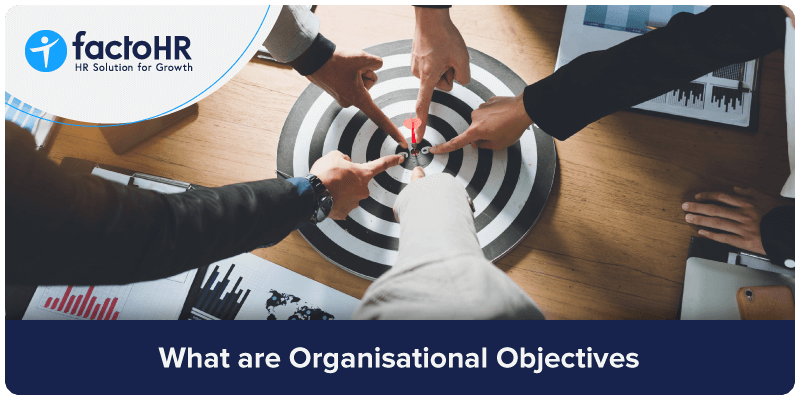What are Organisational Objectives?

Table of Contents
A business or an organisation is a collection of people, processes and tools; together set out to deliver something of value to its customers and stakeholders; and profits to its investors. In this process, the leadership or owner of the business defines what they set out to do and how. Those statements become the vision, mission, objectives for the organisation. The relationship of these terms is hierarchical – one helps define the next.
The vision statement of an organisation is the overarching philosophy describing its long-term goals and aspirations. It provides a direction for the organisation and crystalises what the organisation hopes to achieve in the future.
The mission statement is a statement that describes the organisation’s purpose and the products, services or benefits it provides to its stakeholders. It is the foundation for the organisation’s goals.
Objectives are specific, measurable, and time-bound goals that the organisation sets for itself to achieve its mission. These objectives provide a clear direction and help to focus the organisation’s resources and efforts.
Plans are the specific actions the organisation takes to achieve its objectives and fulfil its mission. They are the concrete steps that the organisation takes to move towards its vision.
The vision statement of the company should be aspirational and reflect the values and mission of the organisation.
Here are some examples of vision statements:
“To become the world’s most respected and innovative technology company, delivering products and services that make the world a better place.” – Apple
“To inspire and nurture the human spirit – one person, one cup and one neighbourhood at a time.” – Starbucks
“To provide every person and every organisation on the planet with the opportunity to achieve more.” – Microsoft

What are Organisational Objectives?
Organisational objectives are the measurable goals that organization tracks to gauge its progress once it has decided on its vision and mission. These objectives often relate to areas such as financial performance, customer satisfaction, employee engagement and business growth. Organisational objectives serve as a kind of map for a company. These unambiguous objectives help companies in decision-making and prioritising where to spend their time and resources. These are used for measuring the progress of the organisation and to identify specific areas of improvement.
Common objectives that organisations pursue are improving profits and customer service, growing into new markets and upgrading employee skills. Clear and specific objectives help organisations to optimise their efforts and resources towards achieving their stated goals.
Why do you Need Organisation-wide Objectives?
Objectives provide common goals and direction for all parts of the organisation to work towards. Here are the key reasons:
Alignment
Clear objectives help align the efforts and resources of various departments of the organisation towards common goals. This translates to a scenario where all employees work on the same objectives thereby increasing efficiency and productivity.
Focus
When the defined objectives have clarity, they provide a clear focus for the organisation. This focus helps to prioritise tasks and allocate resources judiciously.
Direction
They provide direction and guidance for all departments of the organisation, thereby ensuring that the organisation as a whole is moving in the right direction.
Measurement
It is said that what cannot be measured cannot be improved. Objectives of the organisation help measure the success of the organisation and identify any areas of improvement.
Communication
They can be used to communicate the vision and values of the organisation to employees and stakeholders, helping to foster a sense of shared purpose.
What are the Attributes of these Objectives?
Organisation-wide objectives should be similar to individual objectives in terms of their characteristics. They should be SMART:
Specific and clearly defined – helps everyone in the organisation understand what is expected.
Measurable – progress should be quantifiable so that success can be evaluated.
Achievable and Realistic – available resources and capabilities of the organisation should support the objective.
Relevant – to the organisation and aligned with its vision and values.
Time-bound – always have a specific timeline for completion, so that progress can be tracked and deadlines can be met.

How do they Impact the Organisation and the Individuals Working for it?
For the Organisation
They provide a clear direction for the entire organisation and help to prioritise the efforts and resources towards a common organisational goal. This alignment can improve both efficiency and productivity thereby contributing to the overall success of the organisation.
For Individuals
Organisation-wide objectives provide a sense of common purpose and direction for individuals within the organisation. They can help to motivate and engage employees and provide a sense of accomplishment when objectives are achieved.
What are some of the Common Business Objectives?
Increasing Profits
Increasing profits is a business objective that any business can associate with. Businesses can increase profits using different methods such as increasing sales, reducing costs, and improving efficiency.
Expanding Business
Another objective is to expand the company’s reach by foraying into new markets or launching new products or services.
Enhancing Customer Satisfaction
Paying customers’ satisfaction should be one of the top objectives for any organisation. Businesses should aim to improve customer satisfaction through various initiatives like providing high-quality products or services. Performing customer feedback reviews with a view to addressing their needs, concerns and complaints.
Improving Employee Skills
It is proven that increased productivity and a high rate of employee retention are a direct result of investing in employee development. No wonder many successful organisations have this as one of their key objectives.
Reducing Risk
Many businesses aim to reduce risk by implementing strategies such as diversifying their products or services, implementing risk management plans, and insuring against potential losses.
Growing the Business
There are many methods to grow a business. One option is to explore new markets that your business hasn’t reached before. Another approach is to acquire other businesses that complement your own. Launching new products or services is another approach.
Where to Start for Setting Organisational Objectives?
We have learnt what are organisational objectives and how they help. Now let’s understand how to set up these objectives. It is the responsibility of the top leadership to agree upon and be committed to the objectives. It is advisable to set up a workshop to get through this exercise. All the stakeholders who hold a position of authority in providing required resources and/or funding should be part of the workshop.
Vision Statement
Revisit the vision statement to ensure everyone is on the same page in terms of the organisation’s aspirations and what it has set out to accomplish.
Analyse
The current standing of the organisation should be fully analysed and understood. The chosen team can look at current strengths, weaknesses, threats and opportunities that the organisation is facing due to the changing market conditions or other influencing factors. This analysis will reveal areas where the focus is required.
Decide Objectives
The team should brainstorm to state as many objectives as possible. They should take cues from the SWOT analysis to generate ideas for objectives. All the objectives should be defined with SMART attributes. They should then decide upon prioritising the objectives. Making this a team effort ensures that key stakeholders are in agreement with the decisions and assure the required resources for meeting the objective.

Conclusion
Organisation-wide objectives are important for ensuring that the organisation is working towards its goals and making progress towards achieving its vision. By ensuring that their objectives have the right attributes, organisations can set clear and achievable goals that will guide their efforts and help them to measure their success. Organisation-wide objectives can have an immensely positive impact on the organisation and the individuals working for it. By setting and working towards these types of objectives, businesses can improve their performance and achieve their goals.
Grow your business with factoHR today
Focus on the significant decision-making tasks, transfer all your common repetitive HR tasks to factoHR and see the things falling into their place.

© 2025 Copyright factoHR


